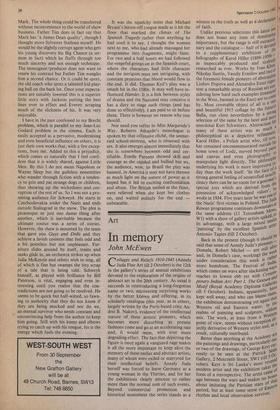Art
In memory
John McEwen
Collages and Reliefs 1910-1945 (Annely Juda Fine Art till 2 October) is the 12th in the gallery's series of annual exhibitions devoted to the exploration of the origins of abstract art in the 20th century. As usual it succeeds in reintroducing a long-forgotten name or two, uncovering surprising works by the better known and offering, in its scholarly catalogue (this year, as in others, largely written by the Paris-based critic An- drei B. Nakov), evidence of the intellectual stature of these artistic pioneers, which becomes more disturbing as present fashions come and go at an accelerating rate and, it would seem, with ever more degrading effect. The fact that depicting the figure is once again a vanguard rage makes it all the more important to keep alive the memory of these earlier and abstract artists, many of whom were exiled or martyred for their intellectual beliefs, Annely Juda herself was forced to leave Germany as a young woman in the Thirties, and for her the exhibitions clearly amount to rather more than the normal sum of such events. Beyond commercial promotion and historical assessment the series stands as a witness to the truth as well as a declaration I ! of faith. Unlike previous selections this latest ono
does not boast any item of dominating'
importance, but the range is still extraordi- nary and the catalogue — half of it devotedv to a supplementary exhibition of the heliographs of Karol Hiller (1889-1934)' as impeccably produced and tirelessly researched as ever. Works by Ivan Winn', Nikolay Suetin, Vassily Ermilov and two oi the foremost female pioneers of abstraction Liubov Popova and Alexandra Exter repre* sent a remarkable array of Russian art ecni; sidering how hard such examples (treasure; in the West, banned in the East) are to enni by. Most covetable object of all is a rare i and beautiful 1915 collage by the NO° Balla, run close nevertheless by a strange selection of the same by the later and Or anecdotal Kurt Schwitters. Abstraction for many of these artists was as rmucha philosophical as a depictive refinernen" Karol Hiller, a POlish artist who, till Olt has remained uncommemorated outside his home town of Lodz, moved beyond pail and canvas and even photographY manipulate light directly. The philos0P"; underlying his work is more impressive t4)-3 day than the work itself. 'In the. face offi. strong general feeling of unsatisfied instil ,c ciency there can be no room for a gourrnet,e special joys which are derived from the possession of acknowledged values of wrote in 1934. Five years later he was oneAa the Nazis' first victims in Poland. The At', Rowan programme continues downstairs at the same address (11 Tottenham Mto' WI) with a show of gallery artists spiked' is its advantage, with a large mixed merit
by the excellent Spanish arti'' Antonio Tapies (till 2 October).
Back in the present (though it should be said that some of Annely Juda's pioneers,.--e Domela, Robert Michel — are still ativic and, in Domela's case, working) the W01... under consideration this week is then dia, humdrum. The Festival of In:; which comes on wave after slackening wave reaches its lowest ebb yet with agilely; porary Indian Art: Part I. The Gesture an Motif (Royal Academy -Diploma Gallen?; till 5 October). Indians, apparently, ha kept well away, and who can blame the the exhibition demonstrating yet again t"the Western oil and Eastern water, in ,r1 realms of painting and sculpture, seld°r; mix. The work, at least from a Weste. point of view, seems without exception ava jectly derivative of Western styles and, as result, culturally moribund.
Better than anything at the Academy are the paintings and drawings, particularly nrir.
,
or two of the drawings, of George KeYtetle rently to be seen at the Patrick efl,7" Gallery, 2 Motcomb Street, SW1 (till 5 tober). Keyt is Sri Lanka's most reverehe modern artist and the exhibition takes t form of a retrospective. The artist carne of age between the wars and makes no bone; about imitating the Parisian stars of ti., period, but at least some sense of Easter' rhythm and local observation survives.






































 Previous page
Previous page